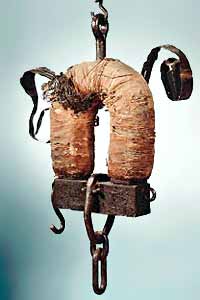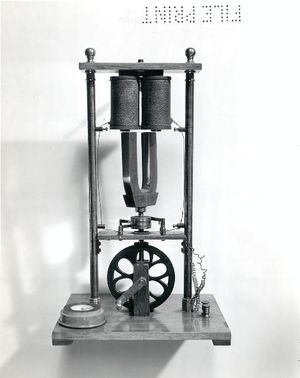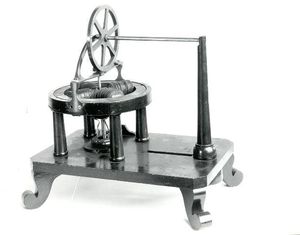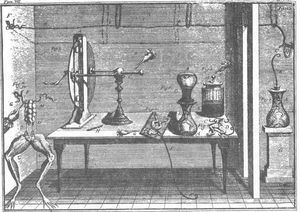Early Applications of Electricity: Difference between revisions
No edit summary |
m (Text replace - "[[Category:Power, energy & industry applications" to "[[Category:Energy") |
||
| (17 intermediate revisions by 3 users not shown) | |||
| Line 1: | Line 1: | ||
== | == Making Electricity Work: Putting Theory into Practice == | ||
[[Image:Horseshoe magnet.jpg|thumb|left|Joseph Henry’s large horseshoe shaped electromagnet from 1831. Henry used it in experiments. Courtesy: Smithsonian Institution.]] | |||
When people realized what electricity and magnetism were they took the first steps towards putting them to work. The very first machines hardly seem useful compared to the stuff we use today, but 200 years ago, when the industrial revolution was getting under way in Europe, they were major breakthroughs. In the 19th century inventors began looking for ways to use [[Electromagnetism|electromagnetism]] to run machines, which was being done at that time by steam engines, water wheels, horses, or even people. | When people realized what electricity and magnetism were they took the first steps towards putting them to work. The very first machines hardly seem useful compared to the stuff we use today, but 200 years ago, when the industrial revolution was getting under way in Europe, they were major breakthroughs. In the 19th century inventors began looking for ways to use [[Electromagnetism|electromagnetism]] to run machines, which was being done at that time by steam engines, water wheels, horses, or even people. | ||
[[Image:Pixiis magneto Generator 0122.jpg|thumb|right|Pixii's magneto generator]] | |||
One of the first to think about using electricity for practical purposes was the American [[Joseph Henry|Joseph Henry]]. In 1829 he used a large battery to build a powerful electromagnet. It was not just a scientific instrument—it could do heavy work, such as lifting hundreds of pounds of metal. With his demonstration, [[Joseph Henry|Henry]] really began to transform electricity into something that people could use every day. | |||
Those interested in using electricity also found new ways to produce electric current. Inventors tried to improve the basic idea of electromagnetic induction and used magnets to create a flow of current in wires. One of the first to invent such a machine was Frenchman Hippolyte Pixii in 1832. Pixii’s machine generated what would today be called an alternating current. It flowed first in one direction and then in the opposite direction. Belgian Floris Nollet improved Pixii’s electromagnetic generator around 1850, and his design was capable of producing about 50 volts. The Nollet generator was the first to be produced in large numbers by a manufacturing firm. They were used in [[Electroplating|electroplating]], the first industrial operation to employ electricity. The Electrical Age was truly under way. | |||
Along with the generator came much more powerful ways to put electricity to work. A key technology was the electric motor. By the 1800 inventors had already harnessed the power of steam to run locomotives and factory machines. Many thought that electricity could be tapped to do the same kind of work, especially after [[Michael Faraday|Michael Faraday]] demonstrated a tiny electric motor. In 1834 Thomas Davenport designed a motor that was strong enough to run a small printing press. He patented the motor in 1837. But progress was slow—it wasn’t until almost 50 years later that electric motors were used commercially. [[Image:Davenport Electric Motor 0115.jpg|thumb|right|Davenport's Electric motor]] <p>[[Image:LySXASJYU2M.jpg|thumb|right|Thomas Edison at his West Orange, N.J., lab, circa 1910, with a battery-powered electric car. Courtesy: National Park Service, Edison National Historic Site]] | |||
[[Image:Frog-legs-lg.jpg|thumb|left|Luigi Galvani and "animal electricity"]] | |||
Davenport also used his motor (which was powered by batteries) to move a small railroad car around a track. Unfortunately, commercial railroad cars were large, and so many batteries were needed that an electric railroad was not practical. But inventors used batteries and motors to power small automobiles beginning in the 1880s. In fact, in 1900 electric automobiles outsold gasoline-powered cars. Today, of course, most cars use gas, but electric cars continue to be developed. Since they do not produce exhaust gas and are easier on the environment than gasoline, they continue to attract interest. | |||
Electricity was also put to work at an early age in the field of medicine. Just three years after the invention of the [[Leyden jar|Leyden jar]] in 1745, doctors in Geneva began to treat patients with electric shocks. A Swiss physician reported that victims of paralysis could sometimes be cured by repeated shocks to their muscles. When [[Luigi Galvani|Luigi Galvani]] announced the discovery of “animal electricity,” doctors were encouraged to continue their experiments. Doctors such as [[Guillaume Duchenne|Guillaume-Benjamin Duchenne]], the “father of electrotherapy,” believed that shocking people with electricity might even cure their ailments. Unfortunately, this type of medicine did not prove effective and became much less common by the early 20th century. But there were many other uses of electricity in medicine that succeeded. The first detection of the electric currents emanating from the brain was made in 1875, and the x-ray machine was introduced in 1895. | |||
However, the most successful practical early use of electricity in the 19th century was the [[Telegraph|telegraph]]. This new form of communication ushered in the era of electrical communication and brought electricity to the forefront of the public’s attention. | |||
<flash>file=motor.swf|width=682|height=410|quality=best</flash> | |||
[[Category:Energy|Electricity]] [[Category:Fields, waves & electromagnetics|Electricity]] [[Category:Medical treatment|Electricity]] [[Category:Electricity|Electricity]] | |||
[[Category:Medical_treatment]] | |||
Revision as of 17:09, 22 July 2014
Making Electricity Work: Putting Theory into Practice
When people realized what electricity and magnetism were they took the first steps towards putting them to work. The very first machines hardly seem useful compared to the stuff we use today, but 200 years ago, when the industrial revolution was getting under way in Europe, they were major breakthroughs. In the 19th century inventors began looking for ways to use electromagnetism to run machines, which was being done at that time by steam engines, water wheels, horses, or even people.
One of the first to think about using electricity for practical purposes was the American Joseph Henry. In 1829 he used a large battery to build a powerful electromagnet. It was not just a scientific instrument—it could do heavy work, such as lifting hundreds of pounds of metal. With his demonstration, Henry really began to transform electricity into something that people could use every day.
Those interested in using electricity also found new ways to produce electric current. Inventors tried to improve the basic idea of electromagnetic induction and used magnets to create a flow of current in wires. One of the first to invent such a machine was Frenchman Hippolyte Pixii in 1832. Pixii’s machine generated what would today be called an alternating current. It flowed first in one direction and then in the opposite direction. Belgian Floris Nollet improved Pixii’s electromagnetic generator around 1850, and his design was capable of producing about 50 volts. The Nollet generator was the first to be produced in large numbers by a manufacturing firm. They were used in electroplating, the first industrial operation to employ electricity. The Electrical Age was truly under way.
Along with the generator came much more powerful ways to put electricity to work. A key technology was the electric motor. By the 1800 inventors had already harnessed the power of steam to run locomotives and factory machines. Many thought that electricity could be tapped to do the same kind of work, especially after Michael Faraday demonstrated a tiny electric motor. In 1834 Thomas Davenport designed a motor that was strong enough to run a small printing press. He patented the motor in 1837. But progress was slow—it wasn’t until almost 50 years later that electric motors were used commercially.
<p>
Davenport also used his motor (which was powered by batteries) to move a small railroad car around a track. Unfortunately, commercial railroad cars were large, and so many batteries were needed that an electric railroad was not practical. But inventors used batteries and motors to power small automobiles beginning in the 1880s. In fact, in 1900 electric automobiles outsold gasoline-powered cars. Today, of course, most cars use gas, but electric cars continue to be developed. Since they do not produce exhaust gas and are easier on the environment than gasoline, they continue to attract interest.
Electricity was also put to work at an early age in the field of medicine. Just three years after the invention of the Leyden jar in 1745, doctors in Geneva began to treat patients with electric shocks. A Swiss physician reported that victims of paralysis could sometimes be cured by repeated shocks to their muscles. When Luigi Galvani announced the discovery of “animal electricity,” doctors were encouraged to continue their experiments. Doctors such as Guillaume-Benjamin Duchenne, the “father of electrotherapy,” believed that shocking people with electricity might even cure their ailments. Unfortunately, this type of medicine did not prove effective and became much less common by the early 20th century. But there were many other uses of electricity in medicine that succeeded. The first detection of the electric currents emanating from the brain was made in 1875, and the x-ray machine was introduced in 1895.
However, the most successful practical early use of electricity in the 19th century was the telegraph. This new form of communication ushered in the era of electrical communication and brought electricity to the forefront of the public’s attention.
<flash>file=motor.swf|width=682|height=410|quality=best</flash>



